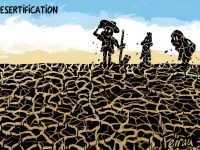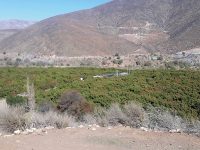Science and policy to combat desertification
The institutional response to a global challenge
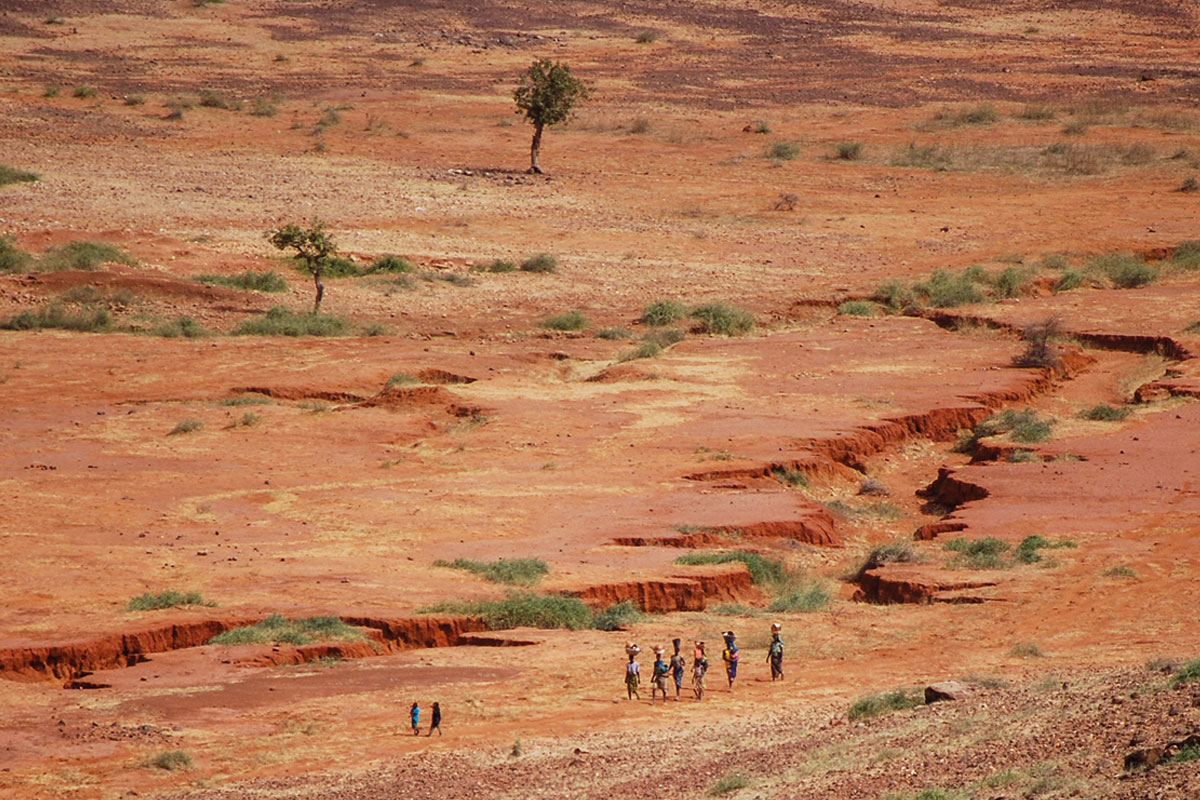
Desertification is a controversial concept whose nature, extent, causes, and potential solutions are still debated. This paper reviews the arguments put forward for considering desertification a global environmental challenge. We also analyse the institutional response within the United Nations system, especially that of the United Nations Convention to Combat Desertification (UNCCD). Thus, the most significant elements of the desertification debate are analysed with respect to their scientific and political dimensions. The text concludes by discussing the need to establish an integrated framework for assessing and responding to desertification that is validated by a science-policy interface.
Keywords: UNCCD, drylands, land degradation, drought, science-policy interface.
Introduction
Desertification is one of the great environmental challenges faced by humankind in the 21st century and was the first to draw international attention towards the need to articulate a global response. Despite this early recognition, desertification is still a controversial concept, and public awareness and understanding of this phenomenon is much lower than that of other global challenges such as climate change and the loss of biodiversity. Most of the actors concerned with desertification – scientists, technicians, politicians and, above all, the affected populations – share a sense of failure when faced with the ineffectiveness of the institutions and initiatives developed in the fight against desertification and with the slow pace and limited progress achieved to date (Toulmin, 2001). The reasons put forward to explain this failure range from questioning the concept of desertification or the relevance of the established institutional architecture to pointing to a lack of interest and political commitment.
This paper reviews the arguments given for considering desertification a global environmental challenge and analyses the institutional response within the United Nations system, in particular that of the United Nations Convention to Combat Desertification (UNCCD). It also reviews and discusses some of the elements that have framed the debate on the concept of desertification at the science-policy interface.
The emergence of desertification in the global environmental agenda
The French forest engineer André Aubréville is thought to have coined the term desertification in 1949 to refer to an extreme case of savannisation: the conversion of tropical and semi-tropical forests in Africa into savannahs (Verstraete, 1986). Desertification soon attracted the attention of the international community and international organisations. As early as the 1950s, the United Nations Educational, Scientific and Cultural Organization launched a research programme on drylands, which to a large extent, set the paradigms that still prevail for dealing with desertification now. The drought crisis in the Sahel in the 1960s and 1970s caused severe human and material losses. It also drew attention to the living conditions of the inhabitants of the region and their dependence on climate conditions, as well as the effects of these phenomena on ecosystems and food security.
In response to this crisis, the United Nations Convention to Combat Desertification (UNCCD) was held in Nairobi in 1977. The Conference adopted the non-binding Plan of Action to Combat Desertification coordinated by UNEP. The plan called on governments to establish a national authority to combat desertification, assess and prioritise the main desertification-related problems, and prepare a national programme with proposals for international assistance. However, implementation of the plan was unsuccessful. Indeed, an evaluation six years later showed that only two in over one hundred affected countries had implemented the plan (Carr & Mpande, 1996). The causes of this failure were the low priority attributed by governments and funding agencies, failure to integrate desertification control policy into the framework of development policies, lack of coordination within the UN system of funding from governments and donors, or attention to social aspects, i.e., the pursuit of technical solutions without considering the socio-political dimensions of desertification. This fiasco led to notable discontent among the affected population, particularly in African countries.
Years later, the discontent grew at the Conference on Environment and Development, commonly known as the Earth Summit, held in Rio de Janeiro in 1992. During this summit, representatives of African countries felt that their problems were underestimated compared to other environmental problems outlined by more developed societies. Namely, climate change caused by a development economy based on fossil fuels and the loss of biodiversity as a consequence of changes in land use resulting from the transformation from rural to industrial and urbanised societies. The Earth Summit finally succeeded when it was able to include a recommendation to the UN General Assembly to start talks for a Convention on Desertification in the resulting Agenda 21 document. This resolution was contested by many developed countries on the grounds that desertification was not a global phenomenon, i.e., that its causes were specific to the affected countries and its solution was therefore not the responsibility of a multilateral international treaty (Corell, 1999).
The results of the negotiations prompted by the Agenda 21 resolution led to the adoption, in June 1994, of the United Nations Conference on Desertification (UNCOD) in countries experiencing serious drought and/or desertification, particularly in Africa, with this agreement entering into force in December 1996.
The uniqueness of the United Nations Convention to Combat Desertification
Several characteristics of the UNCCD set it apart from other multilateral environmental treaties. It was the first Rio Summit treaty negotiated at the behest of developing countries as opposed to developed and industrialised countries, resulting in a strong north-south approach in both its conception and implementation. African countries saw the Convention as an instrument to increase the allocation of development aid funds and to reinforce a centralised model of management with authoritarian control interventions in rural areas (Vogel & Smith, 2002).
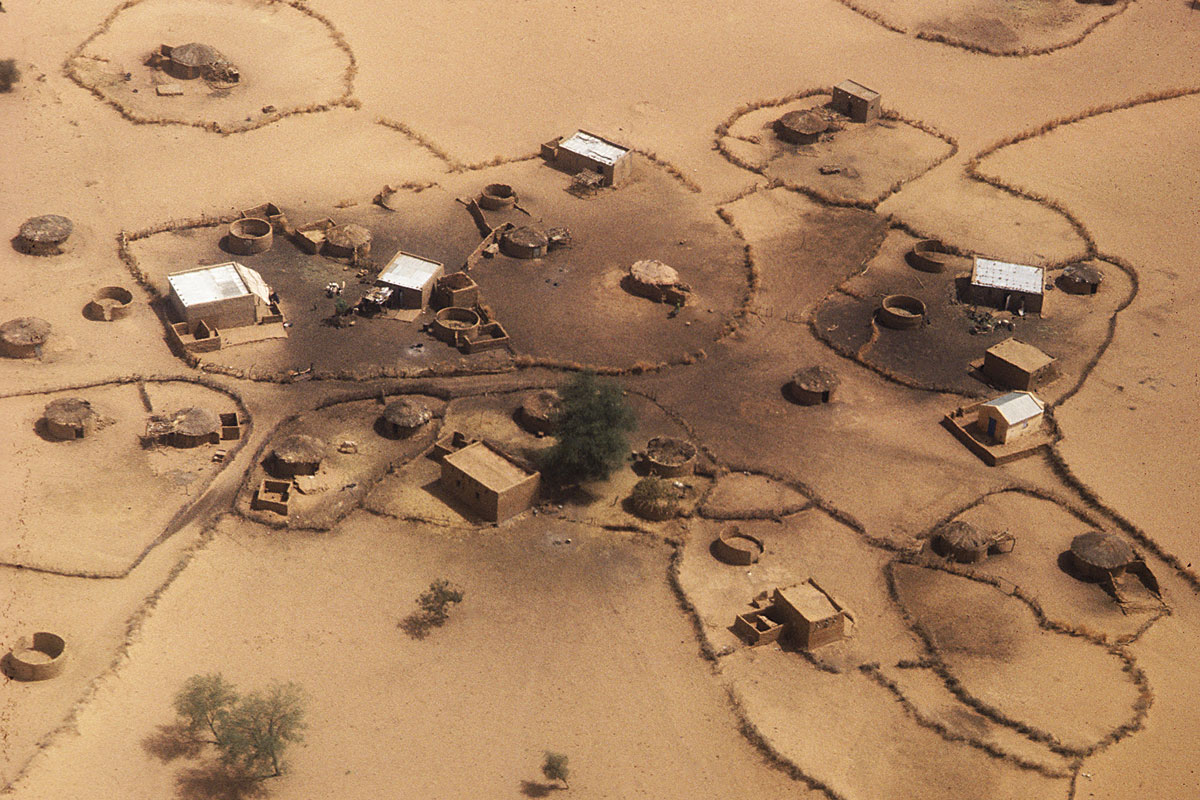
The definition of desertification is not only a matter of terminology or wording; behind a given term lie political implications as to whether or not a solution can be found and who bears the social and financial responsibility for it. One narrative on desertification that has been prevalent in Western forces has been that of desiccation, which attributes the desertification process to poor agricultural and livestock practices by local populations, and neglects climatic factors. The photo shows a drought-stricken village in Mauritania in the 1980s. / UN Photo/John Isaac
However, negotiation of the treaty prioritised the socio-economic dimension of desertification and side lined the scientific debate on the definition, causes, and extent of the phenomenon (Corell, 1999). Nonetheless, the UNCCD can be considered the first treaty on sustainable development because addressed an environmental problem while also considering the social and economic needs of the affected population. The treaty recognised the need for technology transfer from developed countries to affected countries as well as the value of local knowledge and bottom-up participation in the planning, design, and evaluation of measures to control desertification.
A second peculiarity of the UNCCD is its scope; it is a global treaty whose application is restricted to a specific climate zone. According to article 1 of the convention, desertification is «land degradation in arid, semi-arid, and dry sub-humid areas» (UNCCD, 1994). That is, areas in which the ratio of average annual precipitation to average annual potential evapotranspiration, known as the aridity index, is between 0.05 and 0.65. Both humid and hyper-arid areas are therefore outside its scope. The restriction to a particular climate region has called the validity and effectiveness of this instrument in addressing global land degradation problems into question (Stringer, 2008). This argument has even been used by those who question the global nature of the phenomenon.
Unlike the other Rio Conventions, in which all signatory countries felt concerned and affected by the impacts of climate change and biodiversity loss, the signatory countries of the UNCCD can declare themselves as affected or unaffected at their own will. The qualification as an affected country comes with the assumption of obligations that essentially translate into the preparation of a National Action Programme (NAP) to combat desertification. The treaty specifies that only developing countries that declare themselves affected are eligible for financial assistance to combat desertification. This has been one of the recurrent criticisms of the UNCCD, as it may encourage countries to declare themselves affected by desertification regardless of whether there is a scientific basis for doing so.
The role expected of non-affected countries is to provide affected countries with the necessary training, technical assistance, and financial means for the implementation of their NAPs (UNCCD, 1994, Articles 4, 5, and 6). In this sense, mobilisation of financial resources is an essential part of the convention. However, the text is very vague on the commitment of non-affected countries to provide the necessary funds to combat desertification, while emphasising the need for better coordination and efficiency in the use of existing resources. The dichotomy between affected and non-affected countries is reflected in discussions and debates within the framework of the Conference of the Parties (COP). This dynamic is marked by the request for more resources for the implementation of NAPs to combat desertification and a simultaneous demand for greater control and monitoring of the results.
Science and politics in the debate on desertification
Both the scientific and political dimensions of some of the most significant elements of this debate are analysed below.
The definition of desertification: Different narratives
The definition of desertification is not only a matter of terminology or wording; behind a given term lie political implications as to whether or not a solution can be found and who bears the social and financial responsibility for it. This explains much of the confusion surrounding terms. Throughout the desertification debate, two dominant narratives defined, to a certain extent, two opposing schools of thought.
The narrative of desiccation, or crisis, is rooted in the policies of Western powers in their African colonies (Toulmin & Brock, 2016). It argues that the pressures exerted by poor agricultural practices from local populations and overgrazing by nomadic communities lead to a progressive degradation of the vegetative cover to irreversible levels, resulting in reduced rainfall inputs, longer droughts, and the emergence of desert landscapes. However, it does not consider the climatic fluctuations typical of drylands and clearly blames local populations who, in their ignorance, are said to overexploit resources, making them the main contributors to the problem.
This paradigm was accepted by newly independent states to justify the implementation of strongly hierarchical and centralised agricultural and natural resource management policies and settlement programmes for nomadic populations whose living space transcended the new political borders. Indeed, the desiccation model dominated and has guided the development of multilateral global initiatives as well as many bilateral and international organisation development programmes. A paradigmatic example of this narrative is the idea of the advancing Sahara Desert, which has been dismissed by the scientific community but retains a strong evocative power that encourages alarmism and favours immediate action and north-south resource mobilisation.
Notwithstanding, from the 1990s onwards, advances in our knowledge of the climate and the ecology of drylands as well as analysis of the socio-ecological systems associated with them questioned the validity of this paradigm. The analysis of increasingly extensive climatic records for the Sahel confirmed the existence of wetter periods (between 1875 and 1895, and again in the 1950s) alternating with intense and prolonged droughts. This alternation of wet and dry periods suggests that the idea of desiccation may be exaggerated, or even false if the state of the system during a dry period is compared with a baseline state corresponding to a wet period.
Some of the arguments of ignorance and local mismanagement as a cause of desertification were also questioned. Researchers found that many of these populations had developed adaptive mechanisms that allowed them to recover their original state after a disturbance, thereby avoiding irreversible damage. For example, the sedentarisation of livestock farming through measures such as establishing pastures and fencing, produces systems that are more vulnerable and less resilient to drought than the traditional practice of nomadism.
Thus, this line of thought rejects the neo-Malthusian view of population density as a factor of degradation (Tiffen et al., 1994). Rather, it sees combating desertification as an opportunity rather than a crisis (Mortimore et al., 2009) and considers local populations not as the cause of desertification but as active agents of sustainable and adaptive development (Mortimore, 2016). In its most extreme formulation, it goes so far as to deny the existence of desertification, describing it as a «myth» created by international agencies (Thomas & Middleton, 1994). In line with these premises, the role and results of the UNCCD have been strongly criticised because the creation of an international treaty is not considered the most appropriate instrument to address dryland development and improve the living conditions of their populations (Toulmin, 2001).
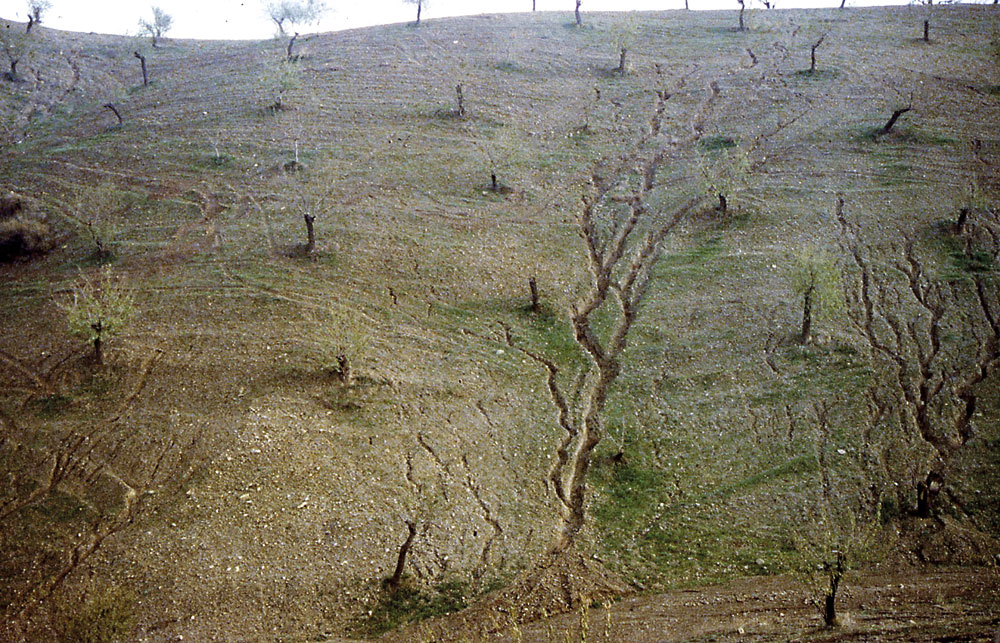
The emphasis placed on the adverse impacts of human action as the main cause of desertification responds to some extent to a strategy to promote a plan of action to combat dryland degradation. If the causes of desertification were natural, there was little scope for action to justify the development of a plan. However, the scientific consensus considers that desertification always includes human and biophysical factors, and none of them can be universally considered as the predisposing factor. In the photograph, erosion processes in the furrows of almond groves in the upper basin of the Guadalentín river, in Murcia (Spain). / Víctor M. Castillo Sánchez
Furthermore, the debate is strongly polarised among experts from the natural sciences and social sciences. Social scientists, who are also conditioned by the scale of the analysis, argue that biophysicists extrapolate from small-scale case studies, while biophysicists accuse social scientists of underestimating the problem of land degradation. This counter-narrative has been described by some authors as just as simplistic as the one it is intended to replace (Stafford-Smith, 2016).
The truth is that many of their arguments are more about the inadequate use of the concept of desertification – either by exaggerating the figures or by using it to justify the adoption of government policies that impact the livelihoods of local communities – than on the existence of the phenomenon itself. Regarding critical views of the role played by the UNCCD, it is worth remembering that, in line with the hypotheses put forward by this new paradigm, one of the characteristics of the negotiation process and of the final approved text is that it recognises the need to strengthen local participation and action. This includes the work of NGOs in the implementation of the UNCCD and the contribution of local and traditional knowledge.
The extension of desertification: Is it a local, regional, or global phenomenon?
Most approaches to determine whether a problem is global or local refer to the consequences and causes of the problem: if they transcend a region, the problem is considered global (Porter & Brown, 1991). Other approaches focus on whether the impact of a problem is transmitted from one country to others, or whether it is confined to one territory but requires the intervention of other countries to resolve it. The debate on whether an environmental problem is global or local is strongly conditioned by its political implications. If the problem is local, there is no justification for an international treaty; whereas if it is classified as global, it receives more recognition and interest, and has more appeal.
The conceptualisation of desertification as a global phenomenon was intensely debated during the negotiation period, with two clearly opposing positions. The OECD and EU countries questioned the global character of the problem and maintained a restrictive interpretation of desertification at all times, avoiding references to issues such as the eradication of poverty. In contrast, developing countries advocated the global character of desertification and drought, based on their social causes and economic impacts. The implications for financial obligations also influenced the debate on whether the convention should address indirect causes such as climate change, international economic relations, or trade. The global-local debate was thus framed within a broader development aid provision debate.
Nonetheless, growing evidence on the relationship between climate change, land degradation, and desertification (Mirzabaev et al., 2019), and on the pressures and impacts the demand for goods and services in developed countries cause in terms of dryland resources (Martínez-Valderrama et al., 2021) justify considering desertification as a global phenomenon that manifests itself locally in different ways.
Another contentious issue was whether deserts can undergo desertification. In other words, should hyper-arid areas be considered in the UNCCD? Safriel (2009) differentiates between desert drylands, including hyper-arid and arid areas, and non-desert drylands. The former are characterised by sparse vegetation cover and low population density, while the latter have more extensive vegetation cover and are more densely populated. Although both types have limited productivity due to water deficits, the risks and opportunities faced by each are different. According to Safriel, the inhabitants of desert drylands have had the opportunity to develop alternative livelihoods linked to the development of renewable energies, the carbon market, or ecotourism. Non-desert drylands, however, are subject to greater human pressure and are more prone to degradation. Other authors (King & Thomas, 2014; Martínez-Valderrama et al., 2020) point out that the unsustainable exploitation of some of the resources in desert areas (such as water stored in fossil aquifers with no or very little replenishment), should also be considered as a case of desertification.
Causal attribution
As discussed in the section on desertification narratives, a key element in the definition of the concept is identifying their causes. In their discussion, scientific factors are often intertwined with their political implications.
The UNCOD considered that desertification, understood as the decrease or loss of the biological potential of land, is the result of inadequate management and overexploitation of resources by the population in their quest for better living conditions in a fragile environment. Although the amplifying effect of droughts on degradation processes is recognised, for the UNCOD, it is human activities that directly trigger desertification.
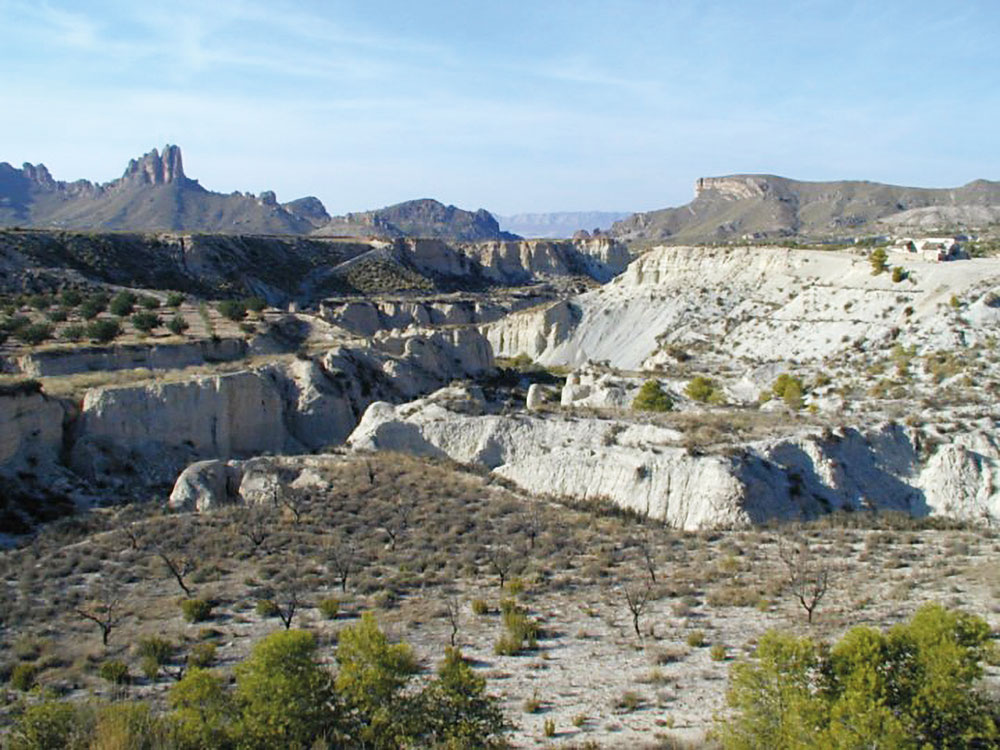
Today, growing evidence on the relationship between climate change, land degradation, and desertification justify considering this as a global phenomenon that manifests itself locally in different ways. In the photograph, rain-fed crops and abandoned land at risk of desertification in the basin of the Cárcavo ravine, in Murcia (Spain). / Víctor M. Castillo Sánchez
The emphasis placed on the adverse impacts of human action as the main cause of desertification responds to some extent to a strategy to promote a plan of action to combat dryland degradation and assist the development of affected populations. The idea was that if the causes of desertification were natural, there was little scope for action to justify the development of a plan, whereas if the cause was human activity, its existence was justified.
The consideration of climatic causes for desertification gained ground between 1977 and 1992, and so the UNCCD mentions both climatic variability and human activity as factors in desertification. This reassessment while preparing the Agenda 21 and in the UNCCD text negotiations also served a political purpose. The inclusion of climate variability as a possible cause of desertification introduced an argument for linking desertification and climate change, thus both reinforcing the global character of the phenomenon and shifting the responsibility onto industrialised countries.
In the face of this controversy, the scientific consensus is unequivocal: desertification always includes human and biophysical factors, and none of them can be universally considered as the predisposing factor (Stafford-Smith & Reynolds, 2002).
Conclusion
Desertification affects the sustainability of socio-ecological systems in drylands. It is a multifactorial phenomenon with a biophysical and a socio-economic dimension that manifests itself differently depending on the territories and time scale considered. This complexity has given rise to a fragmented body of knowledge and perspectives in both the scientific and political arenas.
An adequate approach to the problem of desertification and improvement of the living conditions of people living in drylands requires an integrated assessment and response framework. Such a framework must analyse desertification as the result of human-environment interactions and must include political, social, and economic processes at different spatial and temporal scales.
The development and adoption of this integrated framework for combating desertification has been hampered by the absence of an independent panel of experts, similar to the role played by the Intergovernmental Panel on Climate Change (IPCC) and the Intergovernmental Science-Policy Platform on Biodiversity and Ecosystem Services (IPBES), to report authoritatively to the COP on the various scenarios, data, and interpretations of desertification. The establishment of such a panel has been requested on numerous occasions (Thomas et al., 2012). However, while recognising the need for greater scientific soundness in the arguments put forward for policy decision-making to combat desertification, donor countries have opposed the establishment of a new panel. As an alternative, they have urged the UNCCD to build on the work of existing panels and platforms by creating a science-policy interface. The aim of this interface would be the translation of scientific knowledge into non-prescriptive recommendations for decision-making and resolution-making during the COP (Akhtar-Schuster et al., 2016). Although progress was made with the creation of the science-policy interface to establish a framework for authoritative debate between the two communities, compared to other panels, its mandate and available resources suggest that desertification has once again been relegated to the back burner among the global environmental agenda priorities of developed countries.
References
Akhtar-Schuster M., Amiraslani, F., Diaz Morejon, C. F., Escadafal, R., Fulajtar, E., Grainger, A., Kellner, K., Khan, S. I., Perez Pardo, O., Sauchanka, U., Stringer, L. C., Reda, F., & Thomas, R. J. (2016). Designing a new science-policy communication mechanism for the UN Convention to Combat Desertification. Environmental Science & Policy, 63, 122–131. https://doi.org/10.1016/j.envsci.2016.03.009
Carr, S., & Mpande, R. (1996). Does the definition the issue matter? NGO influence and the international Convention to Combat Desertification in Africa. The Journal of Commonwealth and Comparative Politics, 34(1), 143–166. https://doi.org/10.1080/14662049608447720
Corell, E. (1999). The negotiable desert: Expert knowledge in the negotiations of the convention to combat desertification. Linkoping Studies in Arts and Science No. 191. Linkoping University.
King, C., & Thomas, D. S. G. (2014). Monitoring environmental change and degradation in the irrigated oases of the Northern Sahara. Journal of Arid Environments, 103, 36–45. https://doi.org/10.1016/J.JARIDENV.2013.12.009
Martinez-Valderrama, J., Guirado, E., & Maestre, F. T. (2020). Desertifying deserts. Nature Sustainability, 3, 572–575. https://doi.org/10.1038/s41893-020-0561-2
Martinez-Valderrama, J., Sanjuan, M. E., del Barrio, G., Guirado, E., Ruiz, A., & Maestre, F. T. (2021). Mediterranean landscape re-greening at the expense of South American agricultural expansion. Land, 10(2), 204. https://doi.org/10.3390/land10020204
Mirzabaev, A., Wu, J., Evans, J., Garcia-Oliva, F., Hussein, I. A. G., Iqbal, M. H., Kimutai, J., Knowles, T., Meza, F., Nedjraoui, D., Tena, F., Turkeş, M., Vazquez, R. J., & Weltz, M. (2019). Desertification. In P. R. Shukla, J. Skea, E. Calvo Buendia, V. Masson-Delmotte, H.-O. Portner, D. C. Roberts, P. Zhai, R. Slade, S. Connors, R. van Diemen, M. Ferrat, E. Haughey, S. Luz, S. Neogi, M. Pathak, J. Petzold, J. Portugal Pereira, P. Vyas, E. Huntley, … J. Malley (Eds.). Climate change and land: An IPCC special report on climate change, desertification, land degradation, sustainable land management, food security, and greenhouse gas fluxes in terrestrial ecosystems. IPCC.
Mortimore, M. (2016). Changing paradigms for people-centred development in the Sahel. In R. Behnke & M. Mortimore (Eds.), The end of desertification? (pp. 65–98). Springer. https://doi.org/10.1007/978-3-642-16014-1
Mortimore, M., Anderson, S., Cotula, L., Davies, J., Faccer, K., Hesse, C., Morton, J., Nyangena, W., Skinner, J., & Wolfangel, C. (2009). Dryland opportunities: A new paradigm for people, ecosystems and development. IUCN, IIED, & UNDP/DDC.
Porter, G., & Brown, J. W. (1991). Global environmental politics. Westview Press.
Safriel, U. (2009). Deserts and desertification challenges but also opportunities. Land Degradation and Development, 20, 353–366.
Stafford-Smith, D. M. (2016). Desertification: Reflections on the mirage. In R. Behnke & M. Mortimore (Eds.). The end of desertification? (pp. 539–560). Springer. https://doi.org/10.1007/978-3-642-16014-1
Stafford-Smith, D. M., & Reynolds, J. F. (2002). The Dahlem desertification paradigm: A new approach to an old problem. In J. F. Reynolds & D. M. Stafford-Smith (Eds.), Global desertification. Do humans cause deserts? (pp. 403–424). Dahlem University Press.
Stringer, L. (2008). Can the UN Convention to Combat Desertification guide sustainable use of the world’s soils? Frontiers in Ecology and the Environment, 6(3), 138–144. https://doi.org/10.1890/070060
Thomas, R. J., Akhtar-Schuster, M., Stringer, L. C., Marques, M. J., Escadafal, R., Abraham, E., & Enne, G. (2012). Fertile ground? Options for a science-policy platform for land. Environmental Science & Policy, 16, 122–135. https://doi.org/10.1016/j.envsci.2011.11.002
Thomas, D. S. G., & Middleton, N. (1994). Desertification: Exploding the myth. John Wiley & Sons.
Tiffen, M., Mortimore, M., & Gichuki, F. (1994). More people less erosion: Environmental recovery in Kenya. John Wiley.
Toulmin, C. (2001). Lessons from the theatre: Should this be the final curtain call for the Convention to Combat Desertification? WSSD Opinion Series. International Institute for Environment and Development.
Toulmin, C., & Brock, K. (2016). Desertification in the Sahel: Local practices meets global narrative. In R. Behnke & M. Mortimore (Eds.), The end of desertification? (pp. 37–64). Springer. https://doi.org/10.1007/978-3-642-16014-1
UNCCD. (1994). The United Nations Convention to Combat Desertification in those countries experiencing serious droughts and/or desertification, particularly in Africa. Secretariat of the United Nations Convention to Combat Desertification.
Verstraete, M. M. (1986). Defining desertification: A review. Climate Change, 9, 5–18. https://doi.org/10.1007/BF00140520
Vogel, C., H., & Smith, J. (2002). Building social resilience in arid ecosystems. In J. F. Reynolds & D. M. Stafford-Smith (Eds.), Global desertification. Do humans cause deserts? (pp. 149–166). Dahlem University Press.


